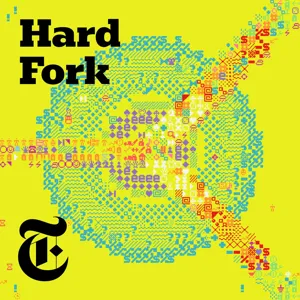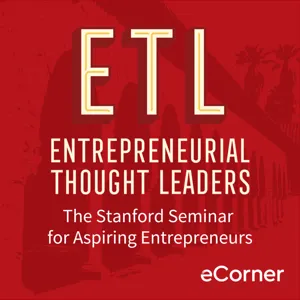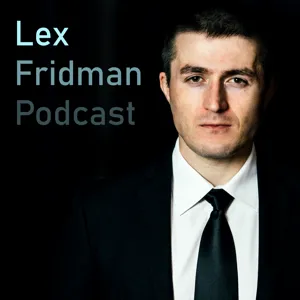Podcast Summary
Exploring the Impact of Generative AI on Art, Creativity, and Ideas: Generative AI is revolutionizing industries by generating new content such as images, videos, and audio, and its impact on art, creativity, and ideas is significant.
We're witnessing a new wave of artificial intelligence (AI) that goes beyond analyzing existing data to generating new content, such as images, videos, and even audio. This technology, known as generative AI, is revolutionizing various industries and making headlines in Silicon Valley. During this episode of Hard Fork, we'll explore the impact of generative AI on art, creativity, and ideas, and discuss its potential implications with Emmy Admostock, the founder and CEO of Stability AI. Although AI is not a new concept, the recent advancements in generative AI have made it more prominent and consequential in our daily lives. It's important to note that while there's hype surrounding this technology, there have also been significant breakthroughs in what's possible with AI in the past few years. In the past, CEOs often promised to solve problems with AI, but it didn't seem to materialize in everyday applications. However, with the launch of DALL-E, a generative AI model, the potential of AI became more apparent and tangible. In this episode, we'll dive deeper into the capabilities and implications of generative AI and discuss its potential impact on society.
Shift in AI: From Analytical to Generative: Generative AI models, like GPT 3, can now create human-like text, images, audio, and even code, leading to unexpected and emergent properties, and the future of AI is about enabling them to create and generate content.
We are witnessing a significant shift in the field of Artificial Intelligence (AI), specifically in the area of generative AI. This type of AI, which is only a few years old in its current form, uses techniques like deep learning to learn from data and generate new content. Large language models, such as GPT 3, have been the pioneers in this field, starting with text and later expanding to images, audio, and even code. The recent trend in AI development is characterized by the increasing size of these models, leading to unexpected and emergent properties that make them more creative than analytical tools. For instance, large language models can now generate human-like text, complete code snippets, create images, and even generate short videos. Companies like OpenAI, Google, and Meta are leading this innovation, and the applications of generative AI are vast, from creating illustrations for newsletters to generating code for millions of programmers. The future of AI is not just about making computers smarter, but about enabling them to create and generate content, making them more integral to our daily lives and industries.
Generative AI's Impact on Creative Industries: Generative AI is revolutionizing creative industries like architecture, filmmaking, interior design, and advertising, with companies like DALL E, Midjourney, and Stable Diffusion leading the way. Despite concerns about displacement, organic user growth and industry adoption indicate a promising future.
Generative AI is making a significant impact across various industries, beyond just the tech sphere. It's being adopted by professionals in creative fields like architecture, filmmaking, interior design, and advertising as a valuable tool to enhance their work. With user bases growing rapidly, companies like DALL E, Midjourney, and Stable Diffusion are gaining traction and unlocking immense economic potential, estimated to be worth over a trillion dollars by Sequoia. However, the rise of generative AI also raises concerns about the potential displacement of artists and illustrators. Despite these concerns, the organic user growth and industry adoption suggest that generative AI is here to stay and will continue to reshape the creative landscape.
AI copyright concerns and ethical implications: AI models trained on vast data may generate copyrighted content, leading to ethical concerns and potential misuse. Regulators are calling for federal regulations to address these issues.
The advancement of generative AI technology, such as Stable Diffusion by StabilityAI, raises significant concerns regarding copyright infringement, potential misuse, and ethical implications. These models are trained on vast amounts of data, some of which may be copyrighted, leading to instances of generating copyrighted code or content. The technology has also been used to create nonconsensual nude imagery and violent content. While some models come with safety filters, open-source models like Stable Diffusion can be modified and used without restrictions, increasing the potential for abuse. Regulators are starting to express concerns and call for federal regulations. StabilityAI's CEO, Ahmad Mustaq, recently raised $101 million to expand their supercomputer capabilities and continue research in this field. It is crucial for the industry to address these concerns and ensure that the technology is used ethically and responsibly.
Open-source AI model Stable Diffusion leads to diverse applications: Stable Diffusion's open-source nature fosters creativity, diversity, and freedom of expression, resulting in various applications from image generation to 3D modeling, and contrasts with centralized AI models' potential ethical dilemmas and limited creativity.
Stable Diffusion, an open-source AI model, has led to a multitude of creative applications, from image generation to 3D modeling and architectural drawings. The open-source approach allows for a global community to contribute, resulting in diverse outputs that cater to various contexts. This contrasts with centralized AI models, which may restrict creativity and limit diversity due to their centralized nature and potential ethical dilemmas. The Stable Diffusion team trusts the community to use the technology responsibly and has even announced a prize for the best open-source deepfake detector. The open-source model's flexibility enables the creation of contextually relevant applications, making it a powerful tool for freedom of expression. The team is working on bringing the technology to various regions and industries, ensuring its accessibility to the average person. Overall, the open-source approach to AI development fosters creativity, diversity, and freedom of expression, setting it apart from centralized models.
Revolutionizing Communication and Content Creation with DreamStudio AI: DreamStudio AI is transforming the way we create and communicate with accessible, personalized AI tools for developers and users, offering features like animation, 3D, and video. It's being integrated into other software and is expected to significantly impact human communication, potentially reaching a holodeck or Ready Player One level.
DreamStudio AI is revolutionizing communication and content creation by providing accessible and personalized AI tools for developers and users. Currently, DreamStudio offers an API and its own platform, DreamStudio.ai, which includes features like animation, 3D, and video. These tools are being integrated into other software, such as Canva and Photoshop, allowing users to easily create and edit visual content. DreamStudio AI's goal is to "let people poop rainbows" by lowering the barriers to communication and content creation, making it accessible to everyone. The technology is still evolving, but it's expected to significantly impact human communication in the next few years, potentially reaching a level of realism and ease comparable to the holodeck or Ready Player One experience. The combination of search capabilities and concept understanding in AI is a game-changer for developers, and the increasing investment in augmented reality and AI chips will only make these tools more powerful and advanced.
Generative AI's Role in the Future of Content Creation: Runway's strategy to monetize generative AI models through APIs and custom embeddings, the future of content being generative and assisted, human consciousness and intention remaining crucial, and the potential for increased value of uniqueness and originality.
As the world moves towards the metaverse and the generation of vast amounts of content in various formats, companies will need to focus on their generative AI strategies to keep up. Runway, a company that recently raised $101 million, plans to make money by providing access to their generative AI models through APIs and embedding teams to create custom models for content providers. The future of content is expected to be generative and assisted, enhancing the media space rather than replacing it. Human consciousness and intention remain crucial in the creation process, making these tools an extension of us rather than a replacement. The accessibility of these tools, like the printing press opening up access to visual creativity, opens up opportunities for individuals to create and monetize their work. The value of uniqueness and originality is expected to increase as the sector grows.
Regulating AI: Balancing Creativity and Safety: Congresswoman Anna Eshoo's call for AI regulation raises concerns over potential misuse, while some argue it could limit creativity. History of social media regulation offers a cautionary tale. Ultimately, creators and users bear responsibility for AI output.
The debate surrounding the regulation of AI, specifically in the context of Stable Diffusion and its potential misuse, raises important questions about intentionality, responsibility, and the balance between creativity and safety. Congresswoman Anna Eshoo's letter to the US National Security Advisor and the Office of Science and Technology Policy highlights concerns over the creation of violent and pornographic content using AI. This call for regulation echoes the ongoing debate in the European Union, where the focus is on holding AI makers accountable for the end use of their technology. However, some argue that this could limit access to the technology and stifle creativity. The history of social media regulation offers a cautionary tale, as well-intentioned technology can have unintended negative consequences. Ultimately, the responsibility for AI and its output lies with its creators and users, and open dialogue and collaboration are essential to navigating the potential risks and benefits of this technology.
Exploring the Positive and Negative Consequences of Technology Development on Decentralized Platforms: Decentralized platforms offer opportunities for creation and community building, but require trust, safety, and transparency. Profit-driven incentives of centralized companies can be detrimental, and a decentralized approach with open access to code and models can lead to better outcomes. Content policies can help prevent harmful content spread.
The accelerated development and use of technology, specifically in the context of decentralized platforms like Discord, can have both positive and negative consequences. The responsibility to guide and coordinate this development falls on those involved, as the potential for nefarious use is a concern. However, the benefits of creation and community building outweigh the risks. The speakers emphasized the importance of trust, safety, and transparency in technology development, and criticized the incentives of centralized companies to prioritize profits over public good. They suggested that a decentralized approach, with open access to code and models, can lead to better outcomes. Additionally, content policies of major social networks can help prevent the spread of harmful content. While there are risks, the potential for positive change and creativity makes the acceleration of technology development worthwhile.
Exploring the Impact of Stable Diffusion on Art Creation and Copyright Infringement: While Stable Diffusion has led to impressive art and projects, concerns around copyright infringement and artists being replaced by AI are valid. The AI learns from relationships between words and images, and while it can't recreate specific images, it understands concepts. The user's intention determines the ethical use of the tool.
Stable Diffusion, an AI model used on platforms like 4chan for creating art, has been in use for eight weeks and while it has led to some bad content, it hasn't caused significant harm. The model has also resulted in numerous projects and amazing art. However, concerns around copyright infringement and artists being replaced by AI are valid. The AI learns from relationships between words and images, and while it can't recreate specific images from the dataset, it understands concepts. The fear of artists being replaced by AI depends on the definition of an artist. The model can learn any style with just a few images, and it's up to the user's intention to use it ethically or illegally. The interview with Greg Rutkowski, an artist whose work is often used in prompts, highlights the issue of copyright infringement. Overall, Stable Diffusion is a tool, and its output depends on the user's intention.
StabilityAI: Human-like Learning Algorithm for AI Images: StabilityAI uses a learning algorithm for AI images, prioritizes open, interrogable systems, engages with artists for feedback, implements opt-in/opt-out mechanisms, supports community initiatives, maintains a populist alternative stance, and collaborates with big tech.
StabilityAI is using a learning algorithm, not a compression algorithm for creating AI images, making it more akin to a human brain. They are committed to building open, interrogable systems and are actively engaging with the artist community for feedback. They plan to implement opt-in and opt-out mechanisms for artists and are developing tools to support community initiatives. Despite their recent large investment, they aim to maintain their "populist alternative" stance to big tech by giving artists revenue share and involving them in the decision-making process. They are also working with big tech companies to provide them with an outlet to participate in this open infrastructure while ensuring regulation and trust and safety.
Balancing freedom and regulation in AI development: Successful AI development requires a balanced approach, involving community collaboration, stakeholder engagement, and consideration of values and liabilities.
Creating and managing advanced AI technologies involves navigating a complex balance between freedom and regulation. The CEO of Stability, a venture investing in AI, acknowledges the need for a middle ground between unrestricted release and complete control. They've raised funds on their terms, allowing them independence, but understand the challenges of misaligned incentives. The CEO emphasizes the importance of community involvement and collaboration with various stakeholders, including big tech, little tech, regulators, and the public. They acknowledge that their position, with fewer public eyes on them, offers more latitude but comes with increased responsibility. The CEO acknowledges that technology is not neutral but reflects the values of its creators and that they have a responsibility to ensure those values are reflected in their creations. The CEO recognizes the importance of figuring out who is liable for the use of the model and the need to separate these considerations. Overall, the successful development and implementation of advanced AI technologies require a thoughtful, collaborative, and balanced approach.
The Future of Generative AI: Regulation vs. Decentralization: Generative AI's potential to revolutionize industries and accessibility to the public is driving the push for decentralization, while regulation seeks to ensure responsible use and prevent misuse.
While social media platforms are moving towards more regulation and centralization, the market for generative AI is pushing for openness and decentralization. The speaker believes that this difference is due to the personal nature of AI-generated content and its potential to revolutionize various industries, including law, medicine, science, and journalism, in the next 10 to 20 years. The speaker also emphasizes the importance of making this powerful technology accessible to the public, rather than keeping it in the hands of a few. The conversation highlights the transformative potential of generative AI and the need for responsible use and regulation.






